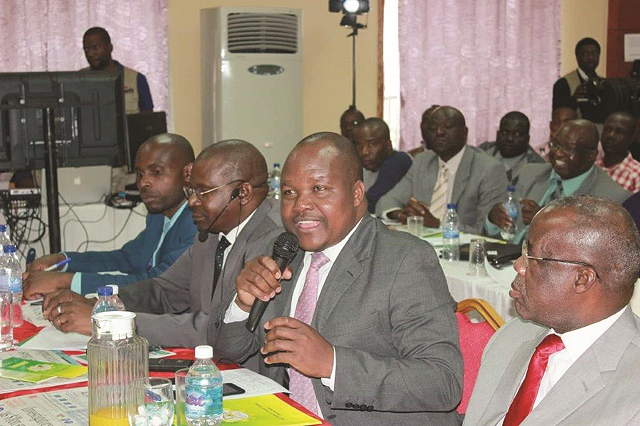STEM: Foundation for a progressive future


Higher and Tertiary Education,Science and Technology Development Deputy Minister Dr Godfrey Gandawa (second from right) responds to questions during the Joint STEM business luncheon in Mutare
Following the successful learning and familiarisation tour of international industry incubating universities in Asia and South America, the Ministry of Higher and Tertiary Education, Science and Technology Development, Zimdef and universities held eight joint STEM luncheons across the country.
The luncheons were aimed at unpacking STEM as a key driver of industrialisation and modernisation as well as the STEM-driven transformational trajectory which universities have since embraced.
The Deputy Minister of Higher and Tertiary Education, Science and Technology Development, Hon Dr Godfrey Gandawa, expressed the need for our education system to adopt global trends in education.
“We cannot continue to ignore the global trend; there is a need for a serious curriculum reform. Students deserve a modern education right now. Instead of 19th century style, students need modern competences, development of a growth mind-set and a strong character,” he said.
He further stated that there is no doubt that Zimbabwe has a serious shortage of STEM skills and therefore a National STEM strategy is urgently required with the help of the Zimbabwe Manpower Development Fund (Zimdef).
“Zimdef should not be burdened by funding low end skills, Zimdef should therefore coordinate this strategy among stakeholders, Institutions of Higher Learning (IHL), business and industry.
He highlighted that globally there is a rise in economic and social problems including obsolete infrastructure, collapsing industry, low productivity, uncompetitive products, huge import bills, extractive culture, low wealth creation, high poverty levels, high disease burdens (emerging and neglected tropical diseases (NTDs)), human capital, rising industry gaps and overall unemployment.
To combat these, STEM education is focusing on encouraging students to embrace emerging technological trends such as Internet of Things (IoT), Industrial Internet of Things (IIoT), Big Data & Data Analytics, 3D Printing, Automation, Cloud Computing, Embedded Intelligence Systems, Genomic Medicine, Nanotechnology, Smart Grids, Digital Transformation, Virtual Technologies (Augmented Reality & Virtual Reality), Cyber Physical Systems and Wireless Sensor Networks. By embracing these several major innovations in digital technology, Zimbabwe will be moving towards Industry 4.0
Speaking at the same luncheons, Zimdef CEO, Mr Fredrick Mandizvidza said now is the time to build the right kind of knowledge, skills and capabilities for Industry 4.0.
“Industry 4.0 is not futuristic speculation, but an industrial transformation already underway. For Zimbabwe to reap the fruits of this revolution, we need to decide and act now!” he said.
He added that as a country, we are in a position to learn from other countries and improve on what they have already achieved.
“We do not have the luxury to stand by and watch other countries exploiting the frontiers of science and technology.
“Industry 4.0 gives us a realistic chance to fight for economic space in the international arena. Others have already embarked on their journey to prosperity,” said Mandizvidza.
According to Mandizvidza there is a real need for strategic and tactical human capital and capacity building to help achieve these goals and more.
“Transformation and mind-set change is a must and not an option. Government, universities and private companies must take a long view at our education system and act now, or else, we relegate future generations to textile weavers in the age of social media.
“By 2025, there is going to be massive demand for industrial data scientists, robot engineers, digital engineers, and 3D-computer-aided design experts,” he said.
The Permanent Secretary for the Ministry of Higher and Tertiary Education, Science and Technology Development, Prof Francis Pedzana Gudyanga, added that the country has come a long way but still has leaps to go.
“It seems Zimbabwe is not yet there in terms of industrialisation as the country lacks Science and Technological advancements. Science and Technology is not a recent discovery but it dates back from 30 years ago where the Government recognised that in order to advance industrially there is a need to accommodate science and technology,” he said.
He added that the major shortage was human capital capacity to advance in technology.
He concurred with Mr Mandizvidza, saying that Zimbabweans should be on the forefront to advance in value addition.
“The Government has always known that there is a need to advance in science and technology and particularly transform huge resources into value added products,” he said.
A total of one thousand and forty-five delegates attended the luncheons countrywide.
The joint STEM luncheons were held in Harare, Bulawayo, Victoria Falls, Kariba, Gweru, Masvingo, Chiredzi and Mutare and 10 public universities and one private university participated at these highly esteemed functions. These were Zimbabwe Open University (ZOU), University of Zimbabwe (UZ), Harare Institute of Technology (HIT), National University of Science and Technology (NUST), Gwanda State University (GSU), Lupane State University (LSU), Bindura University of Science Education (BUSE), Chinhoyi University of Technology (CUT), Midlands State University (MSU), Great Zimbabwe University (GZU) and Africa University (AU).
Industry and the public fully embraced and supported the Ministry’s thrust to transform higher education towards STEM orientation.
Stemitisation is a strategic human capital development thrust that will enable the education system to produce competent graduates for jobs of the future and will help solve the current and future socio-economic challenges of the country.










Comments